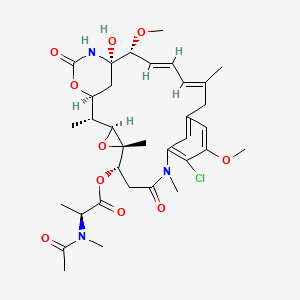| Esteva FJ et al. |
What Can We Learn about Antibody-Drug Conjugates from the T-DM1 Experience? |
2015 |
Am Soc Clin Oncol Educ Book |
pmid:25993162
|
| Martin M and López-Tarruella S |
Emerging Therapeutic Options for HER2-Positive Breast Cancer. |
2016 |
Am Soc Clin Oncol Educ Book |
pmid:27249772
|
| Thigpen JT et al. |
Phase II study of maytansine in the treatment of advanced or recurrent adenocarcinoma of the ovary. A Gynecologic Oncology Group study. |
1983 |
Am. J. Clin. Oncol. |
pmid:6846245
|
| Thigpen JT et al. |
Phase II study of maytansine in the treatment of advanced or recurrent squamous cell carcinoma of the cervix. A Gynecologic Oncology Group study. |
1983 |
Am. J. Clin. Oncol. |
pmid:6869315
|
| Borden EC et al. |
Phase II evaluation of dibromodulcitol, ICRF-159, and maytansine for sarcomas. |
1982 |
Am. J. Clin. Oncol. |
pmid:6956236
|
| Slavik M et al. |
Phase II studies in advanced, recurrent pelvic malignancies: conducted by the Gynecologic Oncology Group, Experimental Design and Experience. |
1982 |
Am. J. Clin. Oncol. |
pmid:6897490
|
| Ravry MJ et al. |
Phase II evaluation of maytansine (NSC 153858) in advanced cancer. A Southeastern Cancer Study Group trial. |
1985 |
Am. J. Clin. Oncol. |
pmid:3834790
|
| Fleming MS et al. |
A reversed-phase high-performance liquid chromatography method for analysis of monoclonal antibody-maytansinoid immunoconjugates. |
2005 |
Anal. Biochem. |
pmid:15840500
|
| Luo Q et al. |
Structural Characterization of a Monoclonal Antibody-Maytansinoid Immunoconjugate. |
2016 |
Anal. Chem. |
pmid:26629796
|
| Sang H et al. |
Conjugation site analysis of antibody-drug-conjugates (ADCs) by signature ion fingerprinting and normalized area quantitation approach using nano-liquid chromatography coupled to high resolution mass spectrometry. |
2017 |
Anal. Chim. Acta |
pmid:28088282
|
| Eichner S et al. |
The interplay between mutasynthesis and semisynthesis: generation and evaluation of an ansamitocin library. |
2012 |
Angew. Chem. Int. Ed. Engl. |
pmid:22135226
|
| Monneret C |
[Current impact of natural products in the discovery of anticancer drugs]. |
2010 |
Ann Pharm Fr |
pmid:20637355
|
| Corrigan PA et al. |
Ado-trastuzumab emtansine: a HER2-positive targeted antibody-drug conjugate. |
2014 |
Ann Pharmacother |
pmid:25082874
|
| Leal M et al. |
Antibody-drug conjugates: an emerging modality for the treatment of cancer. |
2014 |
Ann. N. Y. Acad. Sci. |
pmid:25123209
|
| Luduena RF et al. |
Interactions of vinblastine and maytansine with tubulin. |
1986 |
Ann. N. Y. Acad. Sci. |
pmid:3460446
|
| Gebhart G et al. |
Molecular imaging as a tool to investigate heterogeneity of advanced HER2-positive breast cancer and to predict patient outcome under trastuzumab emtansine (T-DM1): the ZEPHIR trial. |
2016 |
Ann. Oncol. |
pmid:26598545
|
| Foglietta J et al. |
Letter to the editor concerning 'Trastuzumab emtansine (T-DM1) versus lapatinib plus capecitabine in patients with HER2-positive metastatic breast cancer and central nervous system metastases: a retrospective, exploratory analysis in EMILIA'. |
2015 |
Ann. Oncol. |
pmid:25632067
|
| Olson EM et al. |
Responses to subsequent anti-HER2 therapy after treatment with trastuzumab-DM1 in women with HER2-positive metastatic breast cancer. |
2012 |
Ann. Oncol. |
pmid:21531783
|
| Sibaud V et al. |
T-DM1-related telangiectasias: a potential role in secondary bleeding events. |
2015 |
Ann. Oncol. |
pmid:25403586
|
| Gradishar WJ |
Emerging approaches for treating HER2-positive metastatic breast cancer beyond trastuzumab. |
2013 |
Ann. Oncol. |
pmid:23827380
|
